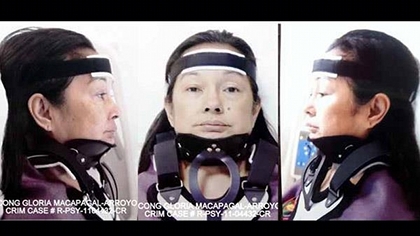SUMMARY
This is AI generated summarization, which may have errors. For context, always refer to the full article.
The last thing this administration wants is to stoke public sympathy for Arroyo.
MANILA, Philippines – Are the photos of former President Gloria Arroyo currently circulating online her real mugshots or not?
Interior and Local Governmen›t Secretary Jesse Robredo said they are not. He is supported by Philippine National Police chief Nicanor Bartolome.
However, Southern Police District Deputy Chief James Bucayu himself admitted to the press that the alleged “mugshots” are real.
So who is telling the truth? Technically, both were.

Real Photos
Digging into this matter, we established that the alleged mugshots were really photographs of former President Arroyo taken around the time the official mugshots were taken.
Move.PH first got hold of copies of the controversial photographs on Monday from a source who had access to people who were there at the time the mugshots were taken.
We sent a copy of the photos to Robredo on Monday morning for him confirm to if those were the real mugshots of former President Arroyo.
Robredo responded by sending us this text message from the Criminal Investigation and Detection Group [CIDG], one of the groups which has access to the mugshot: “Sir, photo not same as picture we submitted to court.”
We pressed Robredo for more details, more indications that the photos were different from the real mugshots. For instance, we asked if the clothes the former president was wearing at the time the mugshots were different from those in the photos.
Robredo responded, “can’t say.” He added, “PGMA camp released photos the day she was about to leave.”
Wrong label
Then late Monday evening, the Inquirer released copies of the Arroyo photographs, attributing them to a source who requested anonymity.
Senior Superintendent James Bucayu of the Southern Police District confirmed that the mugshots the Inquirer published were real but said they were not the source of the “leaked” mugshots. It was the CIDG that took the photos of the mugshots, he explained. (See: Leaked mug shots of Arroyo real – Bucayu )
Yet Robredo once again denied that the photos the Inquirer published were the real mugshots of President Arroyo. “I saw the photos [published in the Inquirer]. They are not same [as the real mugshots],” Robredo told Move.PH.
This time, he offered additional details. Robredo said that the text in the Inquirer photos indicated that the subject of the photo is “Cong. Gloria Macapagal Arroyo.”
In the mugshots submitted to the Pasay Regional Trial Court, the label was “Gloria Arroyo y Macapagal,” Robredo said.
Anyone can take a photo and superimpose case information on the photo, Robredo explained. Even the camp of former President Arroyo, he noted, released photos of GMA before her arrest. “It becomes official if submitted to court, authenticated.”
Chain of custody
Agents of the Philippine National Police Criminal Investigation and Detection Group (PNP-CIDG) took Arroyo’s mugshots at St.Luke’s Hospital in Taguig City, on Saturday, Nov. 19.
On Monday, November 21, CIDG Senior Supt. Joel Coronel turned the mugshots over to the Pasay City regional trial court on Monday, Nov. 21.
The only ones with access to the real mugshots are: the Pasay regional trial court, the Southern Police District, and the Criminal Investigation and Detection Group.
The court issuing the arrest warrant insists it has the final say on whether mugshots of the respondent in a case may be released or not. In this case, the Pasay Regional Trial Court ruled not to allow the release of the mugshots unless they received a request from either party: the Commission on Elections or the Arroyo camp. Some sectors may debate this.
To date, neither camps made any such request.
What happens if the mug shots are leaked and published? As of now, nothing. Pasay clerk of court Joel Pelicano told reporters that the defense would have to file a motion seeking for sanctions first to be approved by the court. The sanctions could include being held in contempt of court.
Pelicano said penalties for contempt include imprisonment (but maybe not more than 6 months, he said) and being fined.
What’s at stake
It is worth noting that the controversial photographs were leaked to the media even before they were submitted to the court.
Until then, with no prior court ruling, it would have been okay for the photographs to have been released as they are considered public documents.
Robredo himself admitted that the photos looked real. He also admitted that it is possible that the photos that eventually found their way to the Inquirer and the social media were also taken around the time the former president’s mugshots were being taken. “We are not sure if the photos were taken at the same as mugshots were taken,” he told Move.PH in a phone interview.
So why the need to quibble over whether these are the real mugshots? The finer details become important, given what’s at stake.
Aquino administration officials previously stressed that they do not intend to subject former president Arroyo to public ridicule. In a previous interview with Move.PH, Robredo stressed that unless legal procedures require it, he would oppose the release of the mugshots.
Simply put, the last thing this administration wants is to stoke public sympathy for Arroyo. The way things are, it already stands accused of violating her personal rights. – Move.PH, with a report from Purple Romero
Add a comment
How does this make you feel?
There are no comments yet. Add your comment to start the conversation.